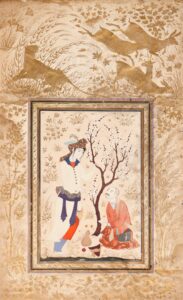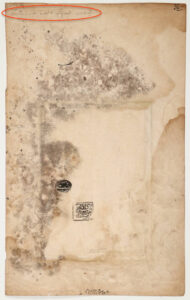 The Rijksmuseum has acquired a unique Persian miniature with a Dutch inscription that dates to the early 17th century. The Dutch handwriting on the back marks the miniature as the earliest known example of Persian art in the Netherlands.
The Rijksmuseum has acquired a unique Persian miniature with a Dutch inscription that dates to the early 17th century. The Dutch handwriting on the back marks the miniature as the earliest known example of Persian art in the Netherlands.
The miniature is 6.9 by 4.6 inches and features a central panel of a stylishly attired young man standing near a tree. A mendicant dervish sits on the ground looking up at him. A frame is drawn in around it and on the other side of the frame is a wide border of gold flowers, plants and birds. Across the top a herd of deer leap away from a hunting tiger.
The drawing was made by a still anonymous artist in Isfahan. On the back of the leaf are two Iranian cancels with the dates 1620/21 and 1630/1. The miniature therefore dates from the time of Shah Abbas the Great (1586-1628). This period is considered the pinnacle of Safawadic art.
These were the earliest days of Dutch engagement with Iran. Abbas had been the first Safavid Shah to make contact with European powers seeking allies against the Ottoman Empire. The first treaty between the Dutch East India Company and Iran, a deal to trade silk, was signed in 1623.
 On the back is an inked inscription that reads “kalawat en sijne mat,” but its precise meaning is unknown. It does appear in Indonesian literature as the world for prince, and “mat” was an abbreviation for “majesty.” Rijksmuseum researchers believe the inscription is a curatorial note, evidence that the miniature was part of a Dutch collection shortly after it was made.
On the back is an inked inscription that reads “kalawat en sijne mat,” but its precise meaning is unknown. It does appear in Indonesian literature as the world for prince, and “mat” was an abbreviation for “majesty.” Rijksmuseum researchers believe the inscription is a curatorial note, evidence that the miniature was part of a Dutch collection shortly after it was made.
Only four other Iranian miniatures with an old Dutch inscription are known. Two of these are also in the collection of the Rijksmuseum. But all four are probably from around 1700 and of a much lesser quality. They may even be specially made for foreign travelers as a souvenir. The miniature that the Rijksmuseum has now acquired is not only of a much higher quality, but also almost a century older.